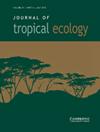Females restrict the position of domatia and suffer more herbivory than hermaphrodites in Myriocarpa longipes, a neotropical facultative myrmecophyte
IF 1
4区 环境科学与生态学
Q4 ECOLOGY
引用次数: 0
Abstract
Domatia are hollow structures in plants occupied by ant colonies, in turn ants provide protection against herbivores. In plants, competition for resources has driven sex-related changes in the patterns of resource allocation to life-history traits and defence traits. The resource-competition hypothesis (RCH) proposes that female plants due to their higher investment in reproduction will allocate fewer resources to defence production, showing greater herbivore damage than other sexual forms. We hypothesise the existence of sex-related differences in defensive traits of domatia-bearing plants, being female plants less defended due to differences in domatia traits, such as size, number of domatia and their position, exhibiting more herbivore damage than hermaphrodite plants of Myriocarpa longipes, a facultative neotropical myrmecophyte. We found eight species of ants inhabiting domatia; some species co-inhabited the same plant, even the same branch. Our results are consistent with the predictions of RCH, as female plants had ant-inhabited domatia restricted to the middle position of their branches and exhibited greater herbivore damage in leaves than hermaphrodites. However, we did not find differences in domatia size and leaf area between sexual forms. Our study provides evidence for intersexual differences in domatia position and herbivory in a facultative ant–plant mutualism in M. longipes. We highlight the importance of considering the plant sex in ant–plant interactions. Differences in resource allocation related to sexual reproduction could influence the outcome of ant–plant interactions.在新热带兼性桃生植物Myriocarpa longipes中,雌性限制了domatia的位置,并且比雌雄同体遭受更多的食草性
Domatia是由蚁群占据的植物中的中空结构,反过来蚂蚁可以保护自己免受食草动物的攻击。在植物中,对资源的竞争促使资源分配模式发生了与性别相关的变化,即生活史特征和防御特征。资源竞争假说(RCH)提出,雌性植物由于其在繁殖方面的更高投资,将更少的资源分配给防御生产,表现出比其他性形式更大的食草动物伤害。我们假设携带domatia的植物在防御性状上存在性别相关的差异,由于domatia性状的差异,如domatia大小、数量和位置,雌性植物防御较少,与兼性新热带桃金娘植物Myriocarpa longipes的两性植物相比,表现出更多的食草动物损伤。我们发现八种蚂蚁栖息在domatia;有些物种共同生活在同一种植物上,甚至是同一个枝条上。我们的结果与RCH的预测一致,因为雌性植物的蚂蚁居住的domatia被限制在其枝条的中间位置,并且在叶片中表现出比雌雄同体更大的食草动物损伤。然而,我们并没有发现不同性形态的多马氏菌大小和叶面积的差异。我们的研究提供了证据,证明了长柄蚁兼性蚂蚁-植物互利共生中多马的位置和草食性的两性差异。我们强调了在蚂蚁与植物的相互作用中考虑植物性别的重要性。与有性生殖相关的资源分配差异可能会影响蚂蚁与植物相互作用的结果。
本文章由计算机程序翻译,如有差异,请以英文原文为准。
求助全文
约1分钟内获得全文
求助全文
来源期刊

Journal of Tropical Ecology
环境科学-生态学
CiteScore
2.10
自引率
0.00%
发文量
44
审稿时长
18-36 weeks
期刊介绍:
Journal of Tropical Ecology aims to address topics of general relevance and significance to tropical ecology. This includes sub-disciplines of ecology, such as conservation biology, evolutionary ecology, marine ecology, microbial ecology, molecular ecology, quantitative ecology, etc. Studies in the field of tropical medicine, specifically where it involves ecological surroundings (e.g., zoonotic or vector-borne disease ecology), are also suitable. We also welcome methods papers, provided that the techniques are well-described and are of broad general utility.
Please keep in mind that studies focused on specific geographic regions or on particular taxa will be better suited to more specialist journals. In order to help the editors make their decision, in your cover letter please address the specific hypothesis your study addresses, and how the results will interest the broad field of tropical ecology. While we will consider purely descriptive studies of outstanding general interest, the case for them should be made in the cover letter.
 求助内容:
求助内容: 应助结果提醒方式:
应助结果提醒方式:


